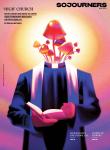On Jan. 18, 2018, Romany Erian Melek Hetta planned to tour the Museum of the Bible in Washington, D.C., with a church group. What began as a journey through the historical and cultural heritage of his religious background turned into a racially and politically charged ordeal. In a civil complaint, Hetta says he was seized, detained, falsely imprisoned, interrogated by security, and reported to the Federal Bureau of Investigation as a terrorist threat. Hetta is an asylee in the United States because of the religious persecution he faced as a Coptic Christian minority in Egypt.
This incident occurred not long after the Museum of the Bible was embroiled in scandal over the provenance and acquisition of its antiquities and manuscript collection. The museum acquired and illegally imported thousands of artifacts from the Middle East between 2010 and 2011 through its founder and main collections donor, Hobby Lobby CEO Steve Green. Just a few months before the museum’s opening in 2017, Hobby Lobby was ordered by the Department of Justice to pay $3 million in fines and forfeit the antiquities to federal authorities for repatriation to Iraq. This year, an investigation found that Oxford classics professor Dirk Obbink appears to have sold the museum stolen papyri, including four he falsely claimed dated to the first century. (Green has since announced intentions to repatriate 5,000 papyri and 6,500 clay objects to Egypt and Iraq, respectively.)
More than just a series of administrative missteps, the museum’s unethical collecting practices and racially based profiling mirror older patterns of American Protestant expropriation of the Middle East’s sacred patrimony at the expense of its Christian populations. For centuries, Western Christians interpreted modern Middle East geographies, customs, and peoples based on narratives of the ancient “Holy Land” outlined in the New and Old Testaments, an approach scholars call Biblical Orientalism. The Museum of the Bible’s troubles are just the latest iteration of this pervasive and long-standing practice.
Edward Said’s profoundly influential 1978 book, Orientalism, describes the term as the West’s portrayal of the East as decadent, static, exotic, and uncivilized. Most importantly, Said’s work emphasizes how these constructions of this exotic “other” are rooted in the West’s need to define itself as different from and superior to the Orient. While his analysis focused on European and American essentializations about Islamic civilization, another implication of orientalism is what these same Western observers thought about their co-religionists in the birthplace of Christianity.
Biblical caricatures
Starting in the 19th century during the Second Great Awakening, an expansive Anglo-American Protestant presence in the Middle East generated closer engagement between foreign and Indigenous Christians through missions, pilgrimage, and scholarly inquiry in the region. The earliest U.S. missionaries arrived under the purview of the American Board of Commissioners of Foreign Missions (ABCFM), eager to convert Muslims across the Ottoman Empire. When they faced setbacks and resistance, they turned to local Christian populations whose practices and beliefs they increasingly considered degenerate and heretical.
Much like their monolithic constructions of the Islamic East, American Protestants framed Christians from the region according to predetermined categories informed by scripture. David Grafton notes that Indigenous Christians, “were not portrayed as real people in their own right but rather as representatives of biblical characters and themes.” Using the Bible as a guidebook, American pilgrims and missionaries generated biblical dictionaries, travelogues, and archaeological guides replete with images and references to sacred landscapes and figures. These texts reflected a desire to see the Middle East as an idyllic pastoral or barren desert land inhabited with archetypes of figures like Noah among 19th century Armenians or Ruth through the activities of rural Middle Eastern women.
Yet “the peoples of the Middle East, their cultures, their languages, and their contemporary matters were too strange, too exotic, and even too un-Biblical for Americans.” These Protestant missionaries and travelers encountered diverse Christian communities with unfamiliar liturgies and clerical hierarchies they considered mired in ignorance and backwardness. Indeed, American missionary Edward Robinson observed that “all ecclesiastical tradition respecting the ancient places in and around Jerusalem and throughout Palestine, is of no value.”
Not only did Middle East Christians fail to meet expectations of imagined biblical caricatures, but Protestants questioned their Christian authenticity altogether. In Egypt, American Presbyterian missionary Andrew Watson wrote that the Indigenous Coptic Orthodox Church resembled “the mummified human body taken out of tombs.” Missionary Henry Harris Jessup, Watson’s contemporary in Beirut, wrote in 1891 that all Christian sects of the Middle East were “ignorant, illiterate, superstitious, idolatrous, despised” and were “an obstacle to the Christianization of the Mohammedan world.” Despite being heirs to the land and patrimony where Jesus lived and conducted his ministry, Middle East Christians were accused of abandoning this sacred connection.
By associating spiritual stagnation with the ecclesiastical traditions of Copts, Maronites, Armenians, Greek Orthodox, and other Christian communities, American Protestant missionaries implied a need for them to be reborn. So they expanded their institutions and projects at the turn of the 20th century in efforts to inculcate “proper” beliefs and behaviors. Motivated by a view that the United States was a “new Israel,” they tasked themselves with ushering a spiritual awakening among Christians living in the land of the “old Israel.” By claiming that local Christians neglected their sacred inheritance, American Protestants assumed a self-appointed role as stewards of its history and heritage.
Systemic exclusion
In efforts to center the Bible in discourse about the Middle East, the ABCFM developed and adopted terms such as “Bible Lands” and “Holy Lands” to refer to the region. This put them in conversation with a broader network of American Christian scholars, diplomats, pilgrims, and travelers who positioned themselves as regional experts and engaged in extractive practices including archaeological excavations, language standardization, and later even racial science research. They became the source and authority of purported “discoveries” of biblical relevance while local Christians became objects of inquiry.
This knowledge production and expertise was only made possible by the special legal, financial, and diplomatic privileges known as the capitulations — concessions given to European and American citizens across the Ottoman Empire during the 19th century. European imperial powers leveraged diplomatic pressure to attain tax exemptions, land sales, and legal jurisdictions favorable to Europeans that incidentally also benefited the expansion of American missionary institutions and projects from Istanbul to Cairo.
Of course, Middle East Christians were (and are) far from the monolithic representations crafted by the biblical orientalist imagination. They hold diverse doctrinal beliefs, worshiped according to different liturgies in several languages, and negotiated, colluded, and resisted missionary categorizations. They also practiced forms of religious and spiritual heritage preservation unacknowledged by American Protestant observers, including religious iconography and musical and oral traditions.
And while not all American Protestants participated in the exclusion of Indigenous Christians from their histories, the prevailing tone of literature generated by them during the height of the missionary enterprise during the late 19th century reflects a hierarchical belief in the superiority of their form of Christian practice.
Building the American mythos
Far from a vestige of the past, the baggage of biblical orientalist practice is still with us. It is what allows Middle East Christian asylees like Hetta to be treated as a threat, and it’s what makes the hasty and unethical management of biblical antiquities easy to forget. It’s what enables people like Oxford professor Dirk Obbink to acquire over 40,000 antiquities from the region and claim, “We’re buyers of items to tell the story” of Christianity and inerrant scripture.
This orientation has also contributed to an inviolable notion of American exceptionalism that inhibits us from reckoning with past and present hubris. The analogies of the United States as a “city on a hill” or a “promised land” leave little room for perspectives that do not glorify American saviorism. American biblical orientalism forges narratives about Christians in the Middle East to reinforce its own vision of Christian identity in the United States.
On July 15, 2019, in the dimly lit Capitol rotunda with the saintly portrait of an apotheosized George Washington overhead, American Pastor Dan Cummings addressed a gathering of Middle Eastern religious leaders and advocates on the eve of the second annual ministerial for religious freedom: “We are in the holy of holies of our nation” he said, “one of its most sacred spots.”
The claim to sacrosanct origins of the United States seemed particularly inappropriate in the presence of leaders who hail from some of the most sacred geographies in the Middle East. This dichotomy was made more acute as Middle Eastern Christian leaders stood in silence as American Christians took the helm of what was meant to be an intra-faith religious service at the heart of the nation’s capital under a mile away from the Museum of the Bible. Although melodic sound reverberated throughout the rotunda as attendees joined in singing of hymns, the silences were deafening.
Got something to say about what you're reading? We value your feedback!








